SAT Subject Test Physics (2012)
PART IV. TWO FULL-LENGTH PRACTICE TESTS
PRACTICE TEST 2
Part A
Directions: Each set of lettered choices refers to the numbered questions of statements immediately following it. Select the one lettered choice that best answers each question or best fits each statement, and then fill in the corresponding oval on the answer sheet. A choice may be used once, more than once, or not at all in each set.
Questions 1-4 refer to the following graphs.

1. Which graph best represents the relationship between pressure and volume at constant temperature?
2. Which graph best represents the relationship between the volume of a gas and the temperature at constant pressure?
3. Which graph best represents the relationship between the average kinetic energy of the molecules of a gas and its temperature?
4. Which graph best represents the relationship between the product PV and P?
Questions 5-9 Which example most closely relates to each example of the interactions between waves and matter.
(A) polarization
(B) absorption
(C) refraction
(D) diffraction
(E) reflection
5. Light striking a surface bounces off the surface at an angle equal to the angle at which it approached.
6. Light passing from one medium to another at an angle is bent because of which phenomenon?
7. Light is passed through a filter that blocks waves vibrating in all directions except one. Which phenomenon explains this observation?
8. A light ray strikes the surface of a medium and is neither returned from the surface or passed through it.
9. Light passing through small openings forms patterns of light and dark regions as a result of interference.
Part B
Directions: Each of the questions or incomplete statements below is followed by five suggested answers or completions. Select the one that is best in each case, and then fill in the corresponding oval on the answer sheet. Do not use a calculator.
10. An object is thrown horizontally at 12 m/s from a bridge that is 36 m above the water. How long does the object take to hit the water below?
(A) 0.3 s
(B) 2.7 s
(C) 3.0 s
(D) 3.6 s
(E) 7.3 s
11. An object is moving toward the right in a straight line at constant speed. Which conclusion(s) about the object can you reach?
I. There are no forces acting on the object.
II. Any forces acting on the object are balanced.
III. A net force toward the right is acting on the object.
(A) I only
(B) II only
(C) III only
(D) I and II only
(E) II and III only
Questions 12 and 13 refer to a 12-V battery that delivers a 1.5-A current to an electric motor connected across its terminals.
12. What is the power of the motor?
(A) 6 W
(B) 8 W
(C) 10 W
(D) 14 W
(E) 18 W
13. The amount of electric energy delivered in 5.0 minutes is
(A) 450 J
(B) 600 J
(C) 1200 J
(D) 2100 J
(E) 5400 J
14. A person exerts an upward force of 110 newtons to accelerate a 10.0-kg stone upward. The acceleration of the stone is
(A) 1.2 m/s2
(B) 1.3 m/s2
(C) 2.2 m/s2
(D) 6.8 m/s2
(E) 9.8 m/s2
15. An airplane starting from rest undergoes a uniform acceleration of 5.2 m/s2 for 15 s from one end of a runway until takeoff. What is the final velocity of the airplane just before takeoff?
(A) 39 m/s
(B) 78 m/s
(C) 117 m/s
(D) 312 m/s
(E) 585 m/s
16. What particles make up an atom of cobalt–60 (![]() Co)?
Co)?
(A) 27 protons, 33 electrons, 60 neutrons
(B) 27 protons, 27 electrons, 33 neutrons
(C) 33 protons, 27 electrons, 27 neutrons
(D) 60 protons, 27 electrons, 27 neutrons
(E) 33 protons, 33 electrons, 27 neutrons
Questions 17–19 relate to the graph below, which represents the motion of Trains A and B in parallel tracks. Train A passes Train B as Train B starts from rest at ![]() .
.
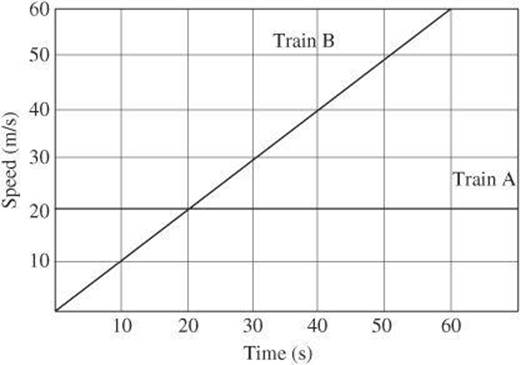
17. Which of the following is represented by the intersection of the two lines?
(A) the distance traveled before the two trains meet
(B) the difference in the distances traveled by the two trains
(C) the time at which the two trains have traveled the same distance
(D) the time at which the two trains begin to move in opposite directions
(E) the time at which the two trains travel at the same speed
18. How far does train A travel between ![]() and
and ![]() ?
?
(A) 50 m
(B) 100 m
(C) 625 m
(D) 1250 m
(E) 2500 m
19. How long does it take train B to catch up with train A?
(A) 20 s
(B) 40 s
(C) 45 s
(D) 60 s
(E) 70 s
20. A resultant force of 10 N is made up of two component forces acting at right angles to each other. If the magnitude of one of the components is 8 N, what is the magnitude of the other component?
(A) 2 N
(B) 6 N
(C) 9 N
(D) 12 N
(E) 18 N
21. A gas in a container with a constant volume has a pressure of 250,000 Pa at 25°C. When the temperature of a gas is increased to 50°C, what is the pressure?
(A) 130,000 Pa
(B) 160,000 Pa
(C) 230,000 Pa
(D) 270,000 Pa
(E) 320,000 Pa
22. Two atoms have the same number of protons and electrons, but different numbers of neutrons. The atoms are different
(A) ions
(B) isotopes
(C) positrons
(D) elements
(E) states
Questions 23 and 24 refer to a ball that is thrown straight up with an initial velocity of 16.5 m/s. The ball is caught at the same height above the ground from which it started.
23. The ball rises to a height of
(A) 2.8 m
(B) 13.9 m
(C) 16.2 m
(D) 19.6 m
(E) 27.2 m
24. What length of time does the ball remain in the air?
(A) 1.7 s
(B) 2.6 s
(C) 3.4 s
(D) 16.5 s
(E) 29.4 s
25. The diagram shows an electric circuit with a resistor R connected to a battery. The current is represented by I, and the power dissipated as heat is P. If the emf of the battery is tripled while R is held constant, the power dissipated in R is
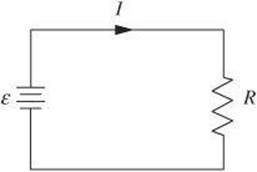
(A) 1/9P
(B) 1/3P
(C) 3P
(D) 6P
(E) 9P
26. A 30.0-N wooden block is at rest on a smooth wooden table. A force of 12.0 N is required to keep the block moving at constant velocity. What is the coefficient of friction for the block and the table?
(A) 0.180
(B) 0.200
(C) 0.400
(D) 0.600
(E) 0.825
27. A satellite moving in a circular orbit with respect to the Earth’s orbit is put into a new circular orbit of larger radius. Which of the following changes, if any, will the satellite experience?
(A) The gravitational force will increase and the speed will decrease.
(B) The gravitational force will decrease and the speed will increase.
(C) Both the gravitational force and the speed will decrease.
(D) Both the gravitational force and the speed will increase.
(E) Neither the gravitational force nor the speed will change.
28. When a vector of magnitude 4 units is added to a vector of magnitude 9 units, the magnitude of the resultant vector could be
(A) 5 units only
(B) 13 units only
(C) 9 units only
(D) 0 units, 9 units, or some value in between
(E) 5 units, 13 units, or some value in between
29. The frequency of a sound wave is heard as its
(A) pitch
(B) loudness
(C) resonance
(D) echo
(E) amplitude
30. What is the missing particle in the nuclear equation below?
![]()
![]()
![]()
![]()
![]()
![]()
31. An object is placed 20.0 cm in front of a converging lens with a focal length of 10.0 cm. How far from the lens is the image formed?
(A) 5 cm
(B) 15 cm
(C) 20 cm
(D) 25 cm
(E) 30 cm
Questions 32 and 33 refer to the energy level diagram for hydrogen.
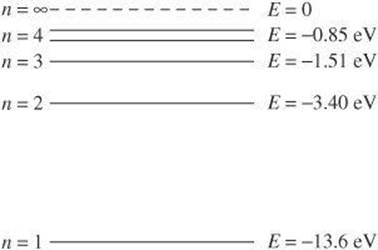
32. Which of the following transitions will produce the photon with the highest frequency?
![]() to
to ![]()
![]() to
to ![]()
![]() to
to ![]()
(D) n = 3 to ![]()
(E) n = 4 to ![]()
33. Which of the following photon energies could not be emitted from the atom after an electron has been excited to the fourth energy level?
(A) 0.66 eV
(B) 1.89 eV
(C) 4.91 eV
(D) 10.2 eV
(E) 13.6 eV
34. A force of 3 newtons and a force of 4 newtons are exerted on a point at right angles to one another. What is the magnitude of the resultant force, in newtons?
(A) 1
(B) 4
(C) 5
(D) 7
(E) 12
35. A change in temperature of 42°C is equivalent to a temperature change of
(A) –231 K
(B) 42 K
(C) 84 K
(D) 142 K
(E) 315 K
36. A negative charge P is located between two unknown charges Q1 and Q2. The net electric force acting on P is zero. Which conclusion may correctly be reached about the unknown charges?

(A) Both Q1 and Q2 are negative.
(B) Both Q1 and Q2 are positive.
(C) Q1 and Q2 have opposite charges.
(D) Q1 and Q2 have the same sign, but Q1 is greater in magnitude than Q2.
(E) Q1 and Q2 have the same sign, but Q2 is greater in magnitude than Q1.
37. By how much would the length of a pendulum need to increase to double the period from 1.00 s to 2.00 s?
(A) 0.248 m
(B) 0.746 m
(C) 0.994 m
(D) 1.24 m
(E) 2.24 m
38. Which examples describe an object moving with nonzero acceleration?
I. A raindrop speeds up as it falls to the ground.
II. A bus slows down as it moves toward a stop.
III. A satellite orbits Earth at a constant speed.
(A) I only
(B) II only
(C) III only
(D) I and II only
(E) I, II, and III
39. What is the current through the circuit shown?

(A) 2.0 A
(B) 4.5 A
(C) 8.0 A
(D) 10.5
(E) 12 A
40. A vibrating sting produces a standing wave. What is the speed of the wave if the length of the string is 2.1 m and the frequency is 60 Hz?

(A) 23 m/s
(B) 29 m/s
(C) 43 m/s
(D) 61 m/s
(E) 84 m/s
41. Which of the following actions will induce a current in a wire?
I. Move the circuit back and forth through a magnetic field.
II. Rotate the circuit in a magnet field.
III. Vary the intensity of a magnetic field while the circuit is in the field.
(A) I only
(B) II only
(C) III only
(D) I and II only
(E) I, II, and III only
Questions 42 and 43 refer to a 20-Ω resistor is connected across a 60-V battery.
42. The current in the circuit is
(A) 2.0 A
(B) 3.0 A
(C) 4.0 A
(D) 10 A
(E) 20 A
43. The energy used by the resistor in 10.0 s is
(A) 0.8 kJ
(B) 1.2 kJ
(C) 1.8 kJ
(D) 2.0 kJ
(E) 6.0 kJ
Questions 44 and 45 refer to the velocity-time graph below.
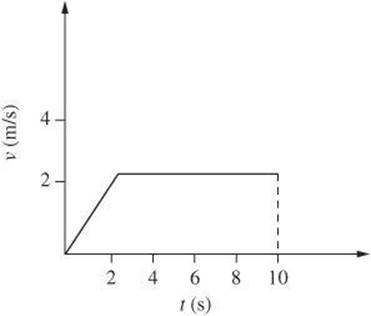
44. The displacement of the object between ![]() and
and ![]() is
is
(A) ½ m
(B) 2 m
(C) 16 m
(D) 18 m
(E) 20 m
45. The acceleration of the object between ![]() and
and ![]() s is
s is
(A) ½ m/s2
(B) 1 m/s2
(C) 2 m/s2
(D) 4 m/s2
(E) 10 m/s2
Questions 46–48 refer to a 0.015-kg rubber stopper that is attached to a 0.85-m length of string and swung in a horizontal circle. The stopper completes one revolution in 1.02 s.
46. The speed of the stopper is
(A) 1.7 m/s
(B) 2.6 m/s
(C) 5.2 m/s
(D) 6.1 m/s
(E) 8.5 m/s
47. The magnitude of the centripetal acceleration directed radially inward is
(A) 5.2 m/s2
(B) 9.8 m/s2
(C) 12 m/s2
(D) 32 m/s2
(E) 51 m/s2
48. The force exerted radially inward by the string is
(A) 0.48 N
(B) 0.52 N
(C) 0.65 N
(D) 0.96 N
(E) 1.10 N
49. The specific heat of iron is ![]() block of iron is heated from 280 K to 305 K. The amount of heat absorbed by the iron is
block of iron is heated from 280 K to 305 K. The amount of heat absorbed by the iron is
(A) 7.6 × 103 J
(B) 8.2 × 103 J
(C) 6.8 × 103 J
(D) 1.1 × 103 J
(E) 2.7 × 103 J
50. A current-carrying wire is placed between the poles of two magnets.
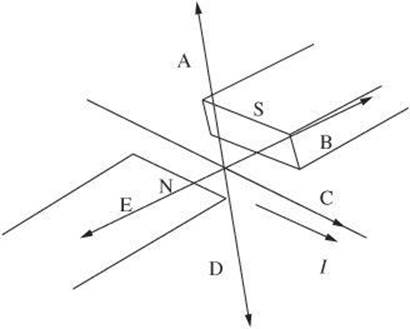
Which arrow shows the direction of the force exerted on the wire?
(A) A
(B) B
(C) C
(D) D
(E) E
Questions 51 and 52 refer to a parallel circuit with four resistors shown below.
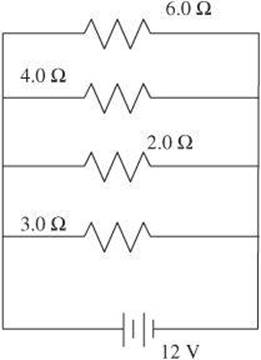
51. What is the equivalent resistance for the circuit?
(A) 0.10 Ω
(B) 0.20 Ω
(C) 0.80 Ω
(D) 0.90 Ω
(E) 1.0 Ω
52. What is the total current in the circuit?
(A) 13 A
(B) 15 A
(C) 20 A
(D) 30 A
(E) 45 A
53. How long does it take for a car to slow from 18 m/s to 2 m/s with a constant acceleration of –1.8 m/s2?
(A) 2.8s
(B) 3.3 s
(C) 8.9 s
(D) 11 s
(E) 16 s
Questions 54 and 55 refer to the wave shown, which has a frequency of 30 Hz.
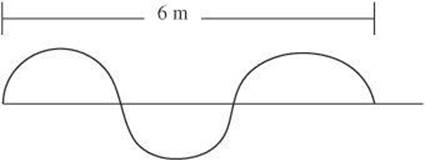
54. What is the wavelength of the wave?
(A) 2 m
(B) 3 m
(C) 4 m
(D) 6 m
(E) 12 m
55. What is the speed of the wave?
(A) 7.5 m/s
(B) 34 m/s
(C) 60 m/s
(D) 120 m/s
(E) 160 m/s
56. A basketball is thrown directly upward. After reaching some peak height, the ball descends and then is caught at the same height from which it was thrown. The upward direction is considered positive for position, velocity, and acceleration. Which signs describe the position, velocity, and acceleration as the basketball rises toward its peak?
(A) position +, velocity +, acceleration +
(B) position +, velocity +, acceleration –
(C) position +, velocity –, acceleration –
(D) position –, velocity –, acceleration +
(E) position –, velocity –, acceleration –
57. Which statement about electric circuits is true?
I. An ammeter must be connected in series.
II. An ammeter cannot be connected in the same circuit as a voltmeter.
III. A voltmeter must be connected in series.
(A) I only
(B) II only
(C) III only
(D) I and II only
(E) I and III only
58. The graph represents the motion of four runners. Which statement about the runners is supported by the graph?
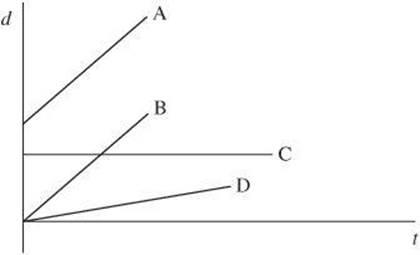
(A) Runner D moves away from the origin with constant velocity.
(B) Runner C starts at a positive coordinate and travels at constant velocity.
(C) Runners B and D have the same velocity.
(D) Runners C and D start from the same point.
(E) Runner A travels with the greatest acceleration.
59. The following processes can be explained by the kinetic molecular theory.
I. evaporation
II. condensation
III. sublimation
Which process(es) involve an increase in energy?
(A) I only
(B) II only
(C) III only
(D) I and II only
(E) I and III only
60. A satellite is in orbit around Earth 265 kilometers above the surface. What is its orbital velocity? [Note the following quantities: Earth radius: 6.37 × 106 m, Earth mass: 5.98 × 1024 kg, and ![]()
(A) 1.05 × 103 m/s
(B) 3.99 × 103 m/s
(C) 9.69 × 106 m/s
(D) 6.26 × 106 m/s
(E) 7.91 × 103 m/s
61. The mass of an object and the net force acting on it is halved. The acceleration of the object is
(A) quartered
(B) halved
(C) unchanged
(D) doubled
(E) quadrupled
62. Which measurement has the least number of significant digits?
(A) 3206 m
(B) 3.26 m
(C) 0.003206 m
(D) 0.0033 m
(E) 3.03 × 10–2 m
63. Which statement about a simple pendulum is true?
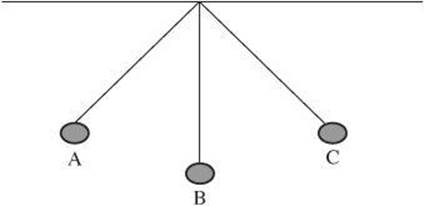
I. The period of swing is dependent on the mass of the bob.
II. The kinetic energy of the bob is greatest as point C.
III. The speed of the bob is greatest at point B.
(A) I only
(B) II only
(C) III only
(D) I or II only
(E) II or III only
64. The diagram shows a simple series circuit. Which of the following would change the current in the circuit to 0.2 A?

I. Decrease the voltage to 3 V.
II. Increase the resistance to 30 Ω.
III. Double the voltage to 12 V.
(A) I only
(B) II only
(C) III only
(D) I and II only
(E) I and III only
65. What is the frequency of a microwave that has a wavelength of 0.032 meter?
(A) 9.600 × 102 Hz
(B) 3.300 × 103 Hz
(C) 9.600 × 106 Hz
(D) 9.300 × 109 Hz
(E) 9.600 × 1010 Hz
66. A car traveling at a velocity of 2.0 m/s at ![]() accelerates at a rate of 3.0 m/s2 for 4.0 s. The velocity of the car at
accelerates at a rate of 3.0 m/s2 for 4.0 s. The velocity of the car at ![]() s is
s is
(A) 10 m/s
(B) 12 m/s
(C) 14 m/s
(D) 16 m/s
(E) 20 m/s
67. The heat of fusion of ice is 3.34 × 105 J/kg. If 6.00 × 103 J is added to a sample of ice, the amount of ice that melts is
(A) 0.0180 kg
(B) 0.0328 kg
(C) 0.204 kg
(D) 0.550 kg
(E) 0.266 kg
68. How does the emission of a beta particle affect the nucleus of an atom?
(A) Increases the atomic number by 1.
(B) Decreases the atomic number by 1.
(C) Increases the mass number by 1.
(D) Decreases the mass number by 1.
(E) Decreases the charge by 1.
Questions 69–71 refer to the wave represented below, which is traveling in the positive x direction with a frequency of 32.0 Hz.
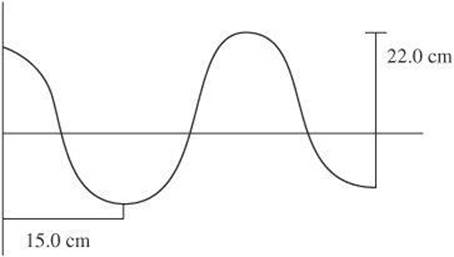
69. The wavelength of the wave is
(A) 11.0 cm
(B) 15.0 cm
(C) 22.0 cm
(D) 30.0 cm
(E) 44.0 cm
70. What is the period of the wave?
(A) 0.03 s
(B) 0.07 s
(C) 6.1 s
(D) 22.0 s
(E) 30.0 s
71. What is the speed of the wave?
(A) 0.09 m/s
(B) 2.9 m/s
(C) 3.0 m/s
(D) 9.6 m/s
(E) 10.7 m/s
72. A 2000-newton object falls freely from rest. If it drops 15 meters, the speed of the object just before it hits the ground is
(A) 15 m/s
(B) 17 m/s
(C) 22 m/s
(D) 25 m/s
(E) 29 m/s
73. Which of the following is the smallest quantity?
(A) 6.2 × 10–1 g
(B) 62 × 10–2 g
(C) 0.0062 × 102 g
(D) 0.0062 g
(E) 0.062 × 10–2 g
74. A steel rod is 5.0 meters long when the temperature is 35°C. If ![]() , by how much does the length of the rod decrease when the temperature drops to –2.0°C?
, by how much does the length of the rod decrease when the temperature drops to –2.0°C?
(A) 2.1 × 10–2 m
(B) 2.2 × 10–3 m
(C) 1.9 × 10–3 m
(D) 6.0 × 10–5 m
(E) 4.4 × 10–4 m
75. The half-life of an element is 24 years. What fraction of a sample of that isotope will remain after 96 years?
(A) 1/24
(B) 1/16
(C) 1/12
(D) 1/8
(E) 1/4
STOP
IF YOU FINISH BEFORE TIME IS CALLED, YOU MAY CHECK YOUR WORK ON THIS TEST ONLY. DO NOT TURN TO ANY OTHER TEST IN THIS BOOK.
ANSWER KEY
1. C
2. B
3. B
4. A
5. E
6. C
7. A
8. B
9. D
10. B
11. B
12. E
13. E
14. A
15. B
16. B
17. E
18. D
19. B
20. B
21. D
22. B
23. B
24. C
25. E
26. C
27. C
28. E
29. A
30. D
31. C
32. E
33. C
34. C
35. B
36. E
37. B
38. E
39. C
40. E
41. E
42. B
43. C
44. D
45. B
46. C
47. D
48. A
49. C
50. A
51. C
52. B
53. C
54. C
55. D
56. B
57. A
58. A
59. E
60. E
61. C
62. D
63. C
64. D
65. D
66. C
67. A
68. A
69. D
70. A
71. D
72. B
73. E
74. B
75. B
QUESTION ANSWERS AND EXPLANATIONS
1. C Boyle’s Law states that the product of pressure and volume remains constant. Therefore, the two quantities have an inverse relationship.
2. B Charles’s Law states that volume is proportional to Kelvin temperature when pressure is held constant. This direct relationship can be represented by a line with a constant positive slope.
3. B The temperature is proportional to the average kinetic energy. This direct relationship can be represented by a line with a constant positive slope.
4. A The product of pressure and volume plotted against either pressure or volume forms a straight, horizontal line.
5. E Reflection occurs when light strikes a surface, changes direction, and then travels away from the surface. This process is known as reflection. According to the law of reflection, the angle the incident light ray makes with the normal is equal to the angle the reflected ray makes with the normal.
6. C When light strikes a new medium at an angle, one part of the ray changes speed before the other. This causes the ray to bend in a process known as refraction.
7. A In polarized light, the waves vibrate in a single plane.
8. B The energy of light is taken into a medium when the light is absorbed.
9. D Diffraction is the apparent bending of light waves around obstacles or through small openings. A diffraction pattern forms on a screen according to the constructive and destructive interference of the waves.
10. B Rearrange the equation ![]() and set the initial position equal to zero to get
and set the initial position equal to zero to get ![]() . Then solve:
. Then solve: ![]() .
.
11. B The motion of the object is constant and, therefore, unchanging. An unbalanced, or net, force would change the motion of the object. Only balanced forces do not change motion.
12. E The power is found by multiplying the potential difference by the current. ![]() .
.
13. E The energy is determined by multiplying the power by the time. ![]() .
.
14. A The weight of the stone is 98.0 N. The person exerts a force of 110 N. The net force acting on the stone is 110 N – 98.0 ![]() . Acceleration equals force divided by mass
. Acceleration equals force divided by mass
![]() .
.
15. B Acceleration equals the change in velocity divided by the change in time: ![]() . Rearrange the equation to solve for
. Rearrange the equation to solve for ![]() .
.
16. B The nuclear symbol for an element shows the atomic number, or number of protons, as a subscript to the left of the symbol. The superscript is the mass number, or total number of nucleons. If the atom is electrically neutral, the number of protons equals the number of electrons.
17. E Train A travels at constant speed, whereas train B increases in speed over time. The intersection represents the time at which both trains are traveling at the same speed.
18. D Train B starts from rest and travels with constant acceleration. The distance traveled is, therefore, found by ![]() .
.
19. B Train A travels with constant speed of 20 m/s. The distance it travels is found according to the equation ![]() . Set this equal to the distance train B travels using the equation
. Set this equal to the distance train B travels using the equation ![]() .
.
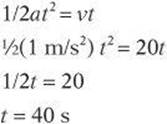
20. B The component vectors make a right triangle with the resultant. Therefore, you can use the Pythagorean Theorem to find the missing value. ![]() , so
, so ![]() .
.
21. D Change the temperatures to the Kelvin scale by adding 273 to each value. Therefore, ![]() and
and ![]() . Then use the relationship between pressure and temperature,
. Then use the relationship between pressure and temperature,
![]()
22. B The number of protons defines the element so that atoms are the same element. Atoms of the same element with different numbers of neutrons are known as isotopes.
23. B At the highest point, the velocity of the ball is zero. Therefore, you know the initial velocity, the final velocity, and the acceleration due to gravity, so you can use the equation ![]() to solve for d. The equation becomes
to solve for d. The equation becomes
![]()
24. C Rearrange the equation ![]() to solve for t. The time t in the equation is the time needed to get to the highest point, and so the total time is double this time, for going up and going down. Therefore,
to solve for t. The time t in the equation is the time needed to get to the highest point, and so the total time is double this time, for going up and going down. Therefore,
![]()
So the total time is 3.4 s.
25. E The power P dissipated by a resistor is given by ![]() , where I is the current in the resistor and V is the voltage across it. Power can also be written as
, where I is the current in the resistor and V is the voltage across it. Power can also be written as ![]() , where R is the resistance. If the emf is tripled while R remains the same, P is multiplied by 9.
, where R is the resistance. If the emf is tripled while R remains the same, P is multiplied by 9.
26. C The coefficient is the ratio of the force to the weight of the block.
![]()
27. C The gravitational force is inversely proportional to the square of the radius of the orbit. As the radius increases, the gravitational force decreases. The centripetal force on the satellite is provided by the gravitational force and is proportional to the centripetal acceleration ![]() . Therefore, v also decreases as the radius increases.
. Therefore, v also decreases as the radius increases.
28. E The magnitude of the resultant vector depends on the angle between the two vectors. The resultant vector will be greatest when both vectors point in the same direction and the angle between them is zero. The resulting vector will have a magnitude equal to the sum of the vectors, or 13 units. The resultant vector will be least when the vectors point in opposite directions and the angle between them is 180 degrees. The resulting vector will have a magnitude equal to the difference between the vectors, or 5 units. For any other angle, the magnitude of the resultant vector will be between 5 units and 13 units.
29. A The frequency determines the pitch of a sound. A high pitch is associated with a greater frequency than a low pitch.
30. D The mass numbers must balance on both sides of the equation: ![]() . The atomic numbers must also balance:
. The atomic numbers must also balance: ![]() .
.
31. C Use the thin-lens equation ![]() . Rearrange to solve for q,
. Rearrange to solve for q, ![]() , so
, so ![]() .
.
32. E The frequency is proportional to the energy, so the photon with the greatest amount of energy will have the highest frequency.
33. C The energy of the photon can equal the difference between any two levels. None of the energy differences equals choice C.
34. C The resultant force can be found by using the Pythagorean Theorem. ![]() , so
, so ![]() .
.
35. B Each unit on the Celsius scale is equivalent to one unit on the Kelvin scale. Therefore, a change of 42°C is equivalent to 42 K.
36. E If the net force on charge P is zero, the forces due to the other two charges must be equal in magnitude but opposite in direction. Q1 and Q2 can both attract or both repel charge P, so they are either both negative or both positive. The force between two point charges is proportional to ![]() . Because Q1 is farther from charge P, its magnitude must be greater than that of Q2.
. Because Q1 is farther from charge P, its magnitude must be greater than that of Q2.
37. B Find the length for a simple pendulum with normal gravity for both periods. For a period of 1.00 s,
![]() . For a period of 2.00 s,
. For a period of 2.00 s, ![]() . The difference is the change:
. The difference is the change: ![]() .
.
38. E An object accelerates when it speeds up, slows down, or changes direction. Therefore, all three examples involve acceleration.
39. C According to Ohm’s Law, I = V/R. So ![]()
40. E The wavelength is 1.4 m. Therefore, the speed of the wave is ![]() .
.
41. E Any relative motion between the field and the wire will result in an induced current.
42. B According to Ohm’s Law, I = V/R. Substitute the given values and solve. ![]() .
.
43. C Find the energy according to the equation ![]() . Substitute the given values and solve.
. Substitute the given values and solve. ![]() .
.
44. D The displacement is equal to the area under the graph. The area from ![]() to
to ![]() s is 1/2(2)(2), or 2 m. The area from
s is 1/2(2)(2), or 2 m. The area from ![]() s to
s to ![]() s is 16 m. The total area, and therefore the displacement, is 18 m.
s is 16 m. The total area, and therefore the displacement, is 18 m.
45. B The acceleration is the slope of the graph between ![]() and
and ![]() s, which is 1 m/s2.
s, which is 1 m/s2.
46. C Use the period of revolution to find the speed. ![]()
47. D Use to find acceleration, use ![]() .
.
48. A The force can be determined from the acceleration and the mass of the stopper: ![]() .
.
49. C The amount of heat depends on the mass, specific heat, and temperature change according to the equation ![]() . Substitute the given information to solve:
. Substitute the given information to solve: ![]()
50. A Using the right-hand rule, point the thumb in the direction of the current and the fingers in the direction of the magnetic field, which is from the north pole to the south pole. The force is exerted upward from the palm.
51. C Total resistance for a parallel circuit is found according to the following equation: ![]() . Using the resistance indicated in the diagram,
. Using the resistance indicated in the diagram, ![]() Then
Then ![]()
52. B The total current is the voltage divided by the equivalent resistance. ![]()
53. C Rearrange the equation ![]() to solve for t. Substitute the given values and solve:
to solve for t. Substitute the given values and solve: ![]() s
s
54. C The diagram shows that the length of 1.5 waves is 6 m. Of that, 2/3 represents 1 wave, which is 4 m.
55. ![]()
56. B As the ball rises, its position is above the point from which it was thrown, so it is positive. The ball is moving upward, so its velocity is positive. The gravitational force is pulling it downward, so the acceleration of the ball is negative.
57. A An ammeter must be connected in series, so there is only one path of current. A voltmeter must be connected in parallel, so the potential difference across an element in the same as the potential difference across the voltmeter. Both instruments can be connected in the same circuit.
58. A For a distance versus time graph, the slope represents the velocity. Runners A and B start at the same positive coordinate and travel with the same velocity. Runner C is at rest. Runner D starts at the origin, but runs at a slower velocity than runner C.
59. E Processes that increase the kinetic energy of a sample include vaporization, of which evaporation is an example, and sublimation. Condensation involves a loss in energy.
60. E The basic equation is ![]() . Substitute the given information and solve:
. Substitute the given information and solve: 
61. C Acceleration is directly proportional to the net force and inversely proportional to the mass: ![]() . The acceleration remains the same.
. The acceleration remains the same.
62. D Choice A has 4, choice B has 3, choice C has 4, choice D has 2, and choice E has 3. Therefore, choice D has the least.
63. C The period of swing is independent of the mass of the bob and dependent on the length of the string. The potential energy is greatest as the points at which the bob changes direction. The kinetic energy and speed is greatest as the bob passes through its lowest point.
64. D According to Ohm’s Law, the quantities are related by ![]() . Increasing the resistance or decreasing the voltage will both decrease the current in the circuit.
. Increasing the resistance or decreasing the voltage will both decrease the current in the circuit.
65. D Frequency depends on wavelength and speed. Use the speed of light in a vacuum for the calculation. ![]()
66. C Choose the equation ![]() , and then solve.
, and then solve. ![]()
67. A The basic equation is ![]() . Rearrange the equation to divide the amount of heat added by the heat of fusion:
. Rearrange the equation to divide the amount of heat added by the heat of fusion: ![]()
68. A A beta particle is an electron produced when a neutron becomes a proton and an electron. The addition of a proton increases the atomic number, and therefore the positive charge, by 1, whereas the mass number remains the same.
69. D The wavelength is one full cycle, or 30.0 cm.
70. A The period is the inverse of the frequency. ![]() .
.
71. D The speed is the product of the frequency and the wavelength, ![]() .
.
72. B The speed of an object falling from rest can be determined by the equation, ![]() . Substitute in the given values:
. Substitute in the given values: ![]() .
.
73. E One method of approaching this question is to rewrite each choice in standard form. The choices then become (A) 6.2 × 10–1 g; (B) 6.2 × 10–3 g; (C) 6.2 × 10–1 g; (D) 6.2 × 10–3 g; (E) 6.2 × 10–4 g. The smallest quantity is then the one with the lowest exponent, which is choice E.
74. B Rearrange the formula for linear expansion to solve for ![]()
75. B The half-life is 24 years, so 96 years is 4 half-lives. After 1 half-life, ½ of the sample remains. After 2 half-lives, ¼ of the sample remains. After 3 half-lives, 1/8 of the sample remains. After 4 half-lives, 1/16 of the sample remains.